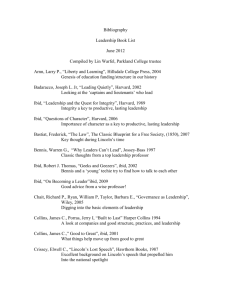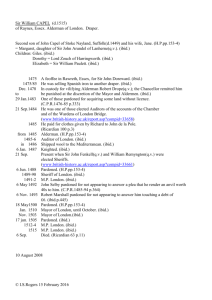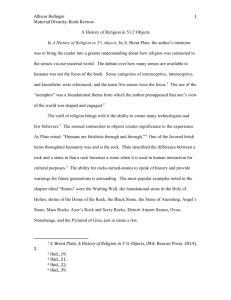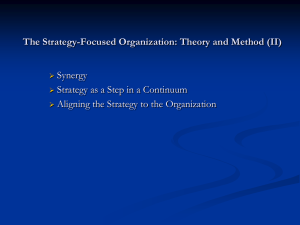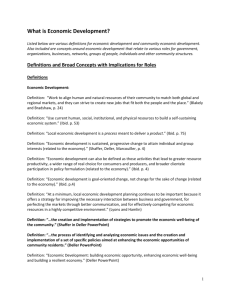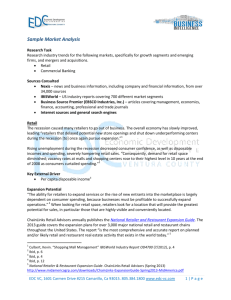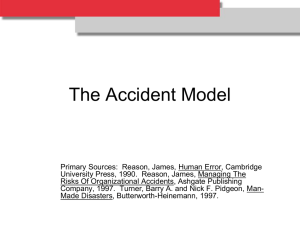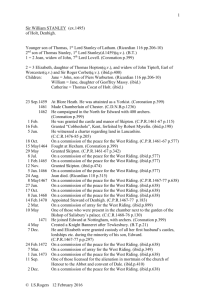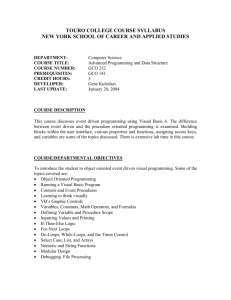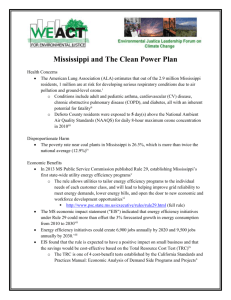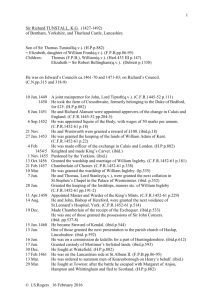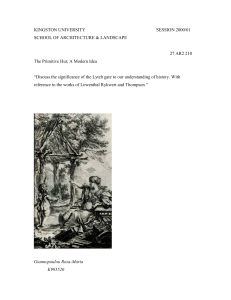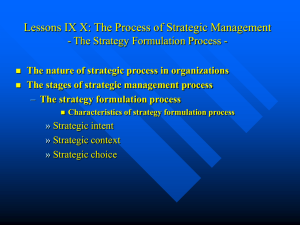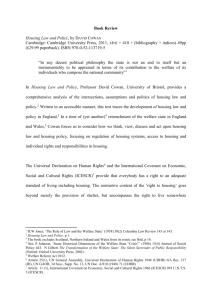India Country Report
advertisement
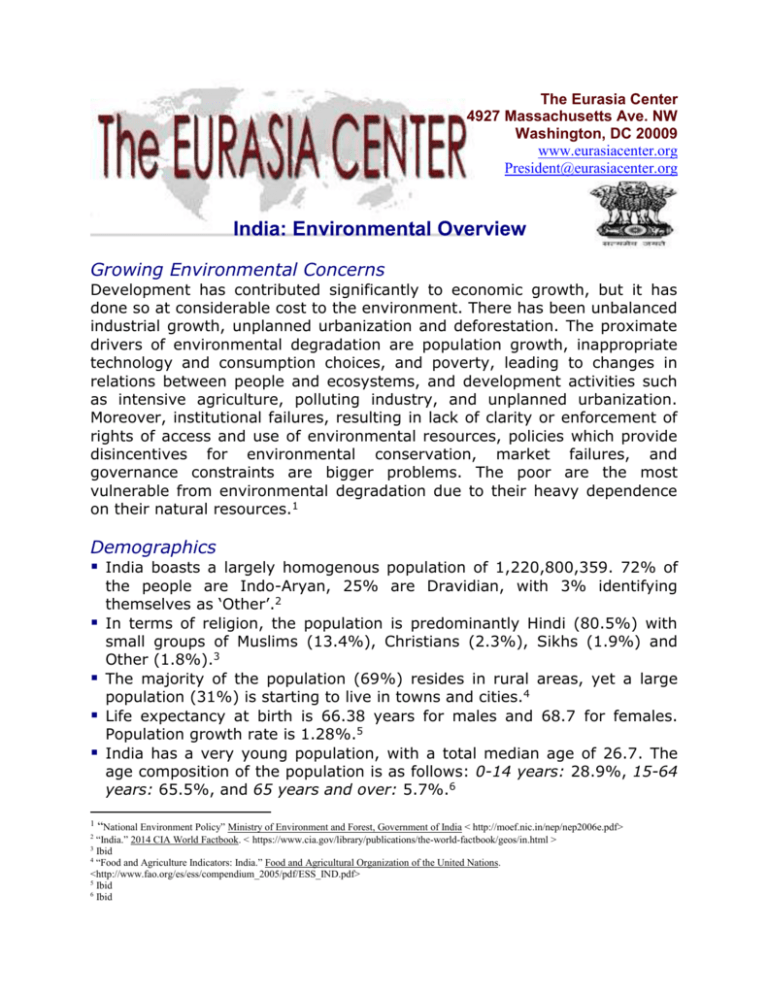
The Eurasia Center 4927 Massachusetts Ave. NW Washington, DC 20009 www.eurasiacenter.org President@eurasiacenter.org India: Environmental Overview Growing Environmental Concerns Development has contributed significantly to economic growth, but it has done so at considerable cost to the environment. There has been unbalanced industrial growth, unplanned urbanization and deforestation. The proximate drivers of environmental degradation are population growth, inappropriate technology and consumption choices, and poverty, leading to changes in relations between people and ecosystems, and development activities such as intensive agriculture, polluting industry, and unplanned urbanization. Moreover, institutional failures, resulting in lack of clarity or enforcement of rights of access and use of environmental resources, policies which provide disincentives for environmental conservation, market failures, and governance constraints are bigger problems. The poor are the most vulnerable from environmental degradation due to their heavy dependence on their natural resources.1 Demographics India boasts a largely homogenous population of 1,220,800,359. 72% of the people are Indo-Aryan, 25% are Dravidian, with 3% identifying themselves as ‘Other’.2 In terms of religion, the population is predominantly Hindi (80.5%) with small groups of Muslims (13.4%), Christians (2.3%), Sikhs (1.9%) and Other (1.8%).3 The majority of the population (69%) resides in rural areas, yet a large population (31%) is starting to live in towns and cities.4 Life expectancy at birth is 66.38 years for males and 68.7 for females. Population growth rate is 1.28%.5 India has a very young population, with a total median age of 26.7. The age composition of the population is as follows: 0-14 years: 28.9%, 15-64 years: 65.5%, and 65 years and over: 5.7%.6 “National Environment Policy” Ministry of Environment and Forest, Government of India < http://moef.nic.in/nep/nep2006e.pdf> “India.” 2014 CIA World Factbook. < https://www.cia.gov/library/publications/the-world-factbook/geos/in.html > 3 Ibid 4 “Food and Agriculture Indicators: India.” Food and Agricultural Organization of the United Nations. <http://www.fao.org/es/ess/compendium_2005/pdf/ESS_IND.pdf> 5 Ibid 6 Ibid 1 2 In 2011, India spent 3.9% of its GDP on health expenditures. Its total health expenditure per capita was $44 (2009).7 Education The Indian education system is composed of both public schools and private, secular and non-secular schools. Total governmental spending on education amounts to 3.2% of GDP8 in 2009. Primary education is 5 years, and secondary education is 7 years; total 9 years of education is compulsory. The number of students pursuing degrees is increasing. In 2009, the gross enrollment ratio for tertiary level education was 16.4%.9 Geography/Natural Resources Located in South Asia, India borders Bangladesh, Bhutan, Burma, China, Nepal, and Pakistan. India maintains a land area of 2,973,190 square kilometers— roughly a third of the United States. It is ranked 7th in the world in terms of total area.10 India has plentiful natural resources including the fourth-largest coal reserve in the world. Other resources include: iron ore, manganese, mica, bauxite, titanium ore, chromite, natural gas, diamonds, petroleum, and limestone.11 India is estimated to have 5.47 billion barrels of oil reserves, and is producing 990,200 barrels of oil/day according to a 2012 estimate.12 India also has about 38 trillion cubic feet (Tcf) of natural gas reserves as of 2007.13 India’s large coal reserve satisfies more than half of India’s energy demands.14 Agriculture While agriculture employs over 47% of the workforce, it only accounts for 17% of Indian GDP. 15 “Core Health Indicators, India.” World Health Organization. “Summary Education Profile: India.” World Bank Group. <http://devdata.worldbank.org/edstats/SummaryEducationProfiles/CountryData/GetShowData.asp?sCtry=IND,India> 9 Ibid 10 Ibid 11 Ibid 12 Ibid 13 “India Natural Gas” Energy Alternatives India < http://www.eai.in/ref/fe/nag/nag.html> 14 Ibid 15 Ibid. 7 8 Permanent crops compose 3.74% of the land, and arable land accounts for over 47.8%, while 35.12% of all agricultural land is irrigated.16 Key crops include: rice, wheat, oilseed, cotton, jute, tea, sugarcane, lentils, onions, potatoes; dairy products, sheep, goats, poultry; fish. 17 Environmental Major Initiatives Objective: Its objective is to build tangible human and technical capacity in selected state agencies for undertaking environmentally sound remediation of polluted sites to support18 In 2011-12, the Indian government allocated 18.22 billion Rupees to the Ministry of Environment and Forests. This accounted for 0.59% of India’s total government spending. 19 The National Environment Policy: comprehensive policy enacted in 2006 which re-examines past conservation efforts and outlines a strategy for policy and legislation reform. Objectives are: (1) conservation of critical environmental resources, (2) intra-generational equity: livelihood security for the poor, (3) intergenerational Equity, (4) integration of environmental concerns in economic and social development, (5) efficiency in environmental resource use, (6) environmental governance, (7) enhancement of resources for 20 environmental conservation Right to Information Act: In order to maintain accountability and transparency, the Ministry of Environment and Forests welcomes queries from public and has made its organizational structure, expenditures, regulations, and procedures public.21 Land An estimated 146.82 Mha. area suffers from various forms of land degradation due to water and wind erosion and water logging.22 Integrated Watershed Development Programme (IWDP): launched in 1989-90 to develop the wastelands on watershed basis, to strengthen the natural resource base and to promote the overall economic 16 Ibid Ibid 18 “National Environment Policy 2006” Government of India: Ministry of Environment and Forests <\http://moef.nic.in/nep/nep2006e.pdf> 19 “Central Plan Outlay by Ministries/Departments.” Government of India: Union Budget & Economic Survey. <http://indiabudget.nic.in/ub2011-12/bag/bag42.pdf> 20 Ibid 21 “Right to Information Act, 2005” Government of India: Ministry of Environment and Forests < http://moef.nic.in/modules/right-to-information/> 22 “State of Environment Report 2009” Government of India: Ministry of Environment and Forests 17 development of the resource-poor and disadvantaged people inhabiting in those areas.22 Air Of the world’s 3 million premature deaths occur each year due to the outdoor and indoor air pollution, the highest numbers are assessed to occur in India.23 Air (Prevention and Control of Pollution) Act: Enacted in 1981, extended the authority of the Central Pollution Control Board to set and enforce regulations for air pollution.24 Kyoto Protocol: India ratified Kyoto Protocol– an international agreement to limit carbon emissions– as a non-Annex I country. Between 1990 and 2010, India’s carbon emissions increased by XX%, and if their carbon emissions continue to increase, their non-participation in the Kyoto Protocol may become a more pressing issue.25 Water Water pollution is a serious problem as almost 75 percent of its surface water resources and a growing percentage of its groundwater reserves are contaminated by biological, toxic, organic and inorganic pollutants. In many cases, these sources have been rendered unsafe for human consumption as well as for other activities such as irrigation and industrial needs.26 National Water Quality Monitoring Programme (MWMP): The monitoring is undertaken on a monthly or quarterly basis for surface water and on a half yearly basis for groundwater. The monitoring network covers 445 rivers, 154 lakes, 12 tanks, 78 ponds, 41 creeks, 25 canals, 45 drains and 807 wells.27 River Boards Act: adopted in 1956, designed to advise the central government on development opportunities, coordinate activities and resolve disputes on the following topics: conservation with a view to “State of Environment Report” Government of India: Ministry of Environment and Forests <http://moef.nic.in/soer/2009/SoE%20Report_2009.pdf> 23 Ibid 24 Ibid 25 “Kyoto Protocol” UNFCCC<http://unfccc.int/kyoto_protocol/items/2830.php> 26 Ibid 27 Ibid 22 control and optimize use of water resources, promotion and operation of schemes related to irrigation, water supply and drainage, promotion and operation of schemes related to hydro-power and flood control, promotion and control of navigation, promotion of afforestation and control of soil erosion, and prevention of pollution. There is a realization of the fact that the Act should be revised and amendments are currently under way to strengthen its power.28 National Lake Conservation Plan: implemented since 2001 for conservation and management of polluted and degraded lakes in urban and semi-urban areas.29 Bay of Bengal Large Marine Ecosystem Priogramme (BOBLME): India, Bangladesh, Indonesia, Malaysia, Maldices, Myanmar, Sri Lanka and Tailand work togegheter to improve the lives of the coastal populations through improved regional management of the Bay of Bengal environment and its fishes.30 Acknowledgements: Research and Data Development Provided by: Kumar Bhattacharya, Research Assistant Under the Supervision and Coordination of: Dr. Gerard Janco, President 28 Ibid “Guidelines for National Lake Conservation Plan” Indian Institute of Technology Roorkee <http://moef.nic.in/downloads/publicinformation/NLCP_guideline.pdf> 30 Ibid 29
